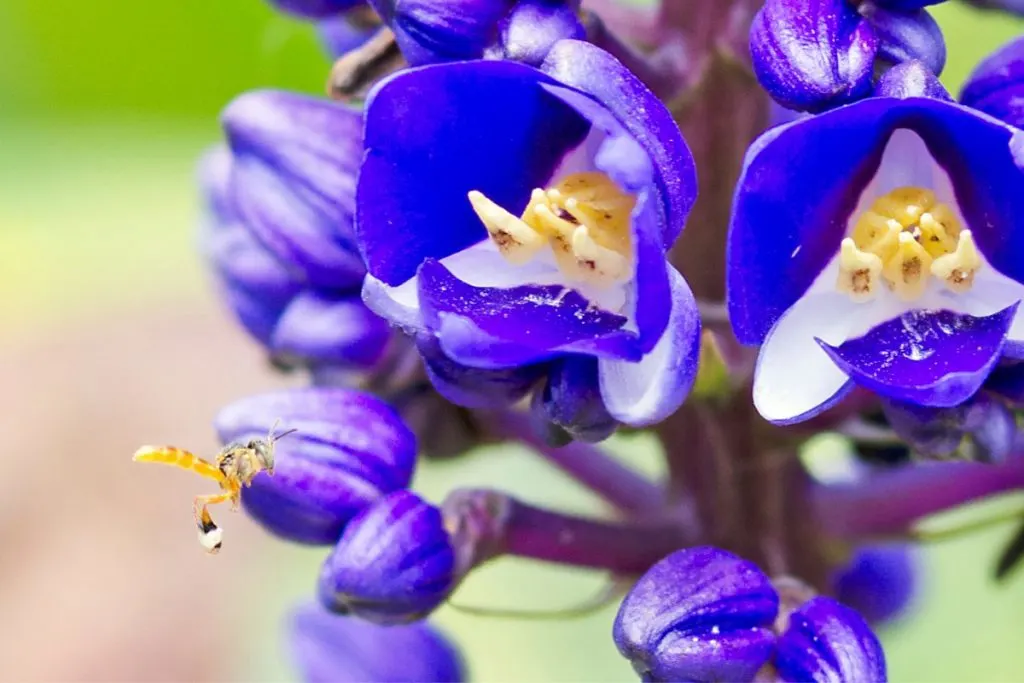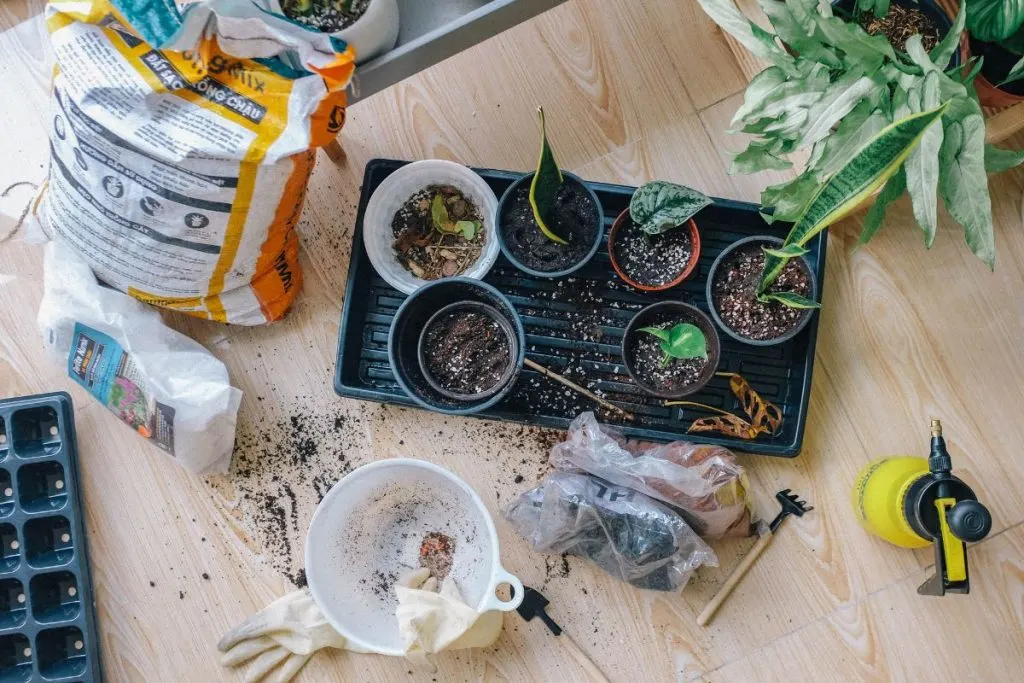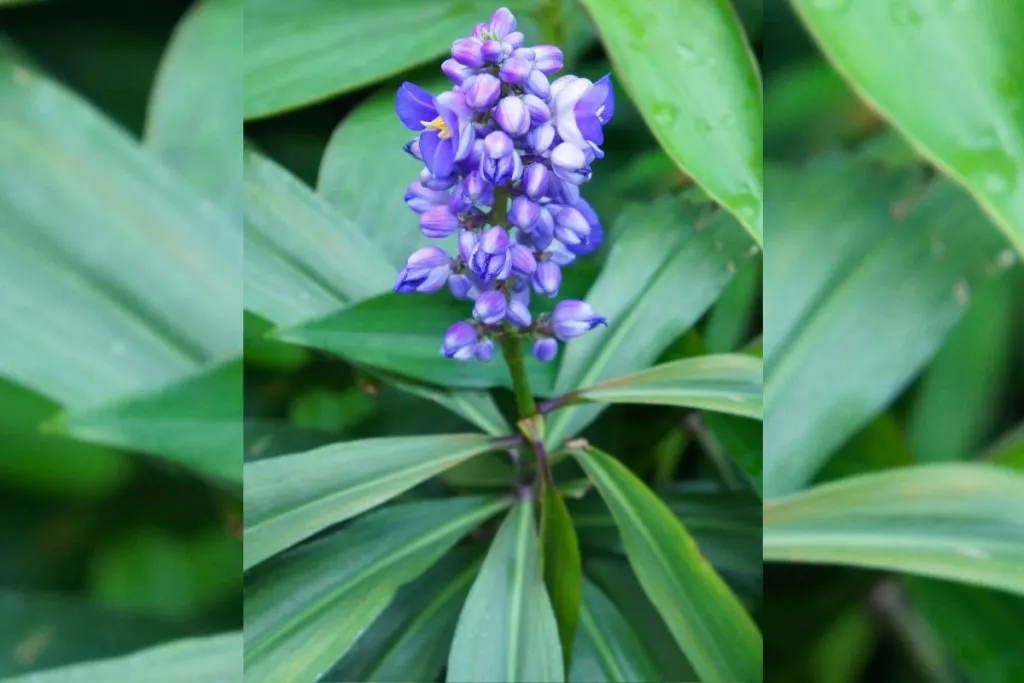We ladies, just love and adore flowers and plants. Maybe it’s because of our care instinct for something. We love all the care we put in for our flowers and plants and we simply enjoy it. Ladies prefer nice colors as well. So they will fall in love with the Blue Ginger Plant.
How do we feel about this heavenly electric blue ginger plant? Once you see its color and the way it looks, you will surely want to plant a blue ginger plant in your garden. It is also called the „grandma plant”. I am not surprised, grandma always knows the best!
So, save some space in your backyard ladies, and buy some garden accessories, blue ginger plant it’s on its way.
What Is A Blue Ginger Plant?

Blue ginger (Dichorisandra thyrsiflora) is a huge plant with large spikes of blue flowers on top of a tall tower of leaves. There are 25 species of blue ginger plants. Fortunately, there is a rather small version of this plant, weeping ginger (Dichorisandra pendula).
The typical height of a blue ginger plant is usually from 1 to 1.5 meters. Its rhizome that grows and expands underground has a bumpy shoot from which the stem grows. The rhizome spreads clustered and fast and a new stem grows from each new shoot. A plant whose growth is not controlled often looks like a sod of plants.
Although their stems and leaves are always elongated and erect, they differ in flower and rhizome color. Although ginger is not grown in large quantities in our areas, several popular species in the world are used in cooking or as medicinal herbs.
About The Nature Of The Blue Ginger Plant

Don’t let the name fool you. Even though its name contains „ginger“, the blue ginger plant isn’t in the same family as the other ginger plants. The main active component in ginger is gingerol which is responsible for its fragrance and flavor.
Even though some think that it’s poisonous, it is not. If you like unusual tastes of food, it is edible and safe to eat. This lovely plant is closer to the Wandering Jew plant family, and let’s be fair, the blue ginger plant is more beautiful than the regular ginger we know. I am sure every woman would fall in love with this blue ornamental plant with big blue flowers.
Another clue that speaks for itself is its texture. Ginger is well known for its rough and firm texture, and this electric blue plant is purely soft and smooth.
Where Does The Blue Ginger Plant Grow?

This beautiful plant originates from South America. Some even say it originates from Brazil because of its love for warmer climates and tropical climates. Believe it or not, some will even comment that blue gingers originate from Hawaii.
Considering the conditions in South America for the floral world, you can easily conclude that the blue ginger plant loves wet weather, humidity but also sunny weather. Depending on its species, the blue ginger plant can go well with home conditions for a plan as well.
About Weeping Blue Ginger (Dichorisandra Pendula)

The weeping ginger plant (Dichorisandra pendula) is not a real member of the Zingiberaceae family but has the appearance of tropical ginger. It is also known as the blue pendant plant and makes an outstanding houseplant.
It blooms every year, and the shiny green leaves are very reminiscent of plants from the ginger family. Growing blue ginger at home or outdoors in warmer regions is easy and provides much-needed color paint almost all year round.
The Blue ginger plant has amazing leaves and flowers. Weeping blue ginger flowers, however, are very different from those plants in the true ginger family. Their flowers have a distinctly tropical look, while what makes the ginger cry is tender and tiny. It hangs from the stem, which leads to the name of the plant blue pendant.
Blue ginger is a member of the spider web and is not related to real ginger. Common with ginger is shiny green, solid arrow-shaped leaves. They dance to a delicate tough stalk that twists, creating a cascading effect.
Blue Ginger Plant Benefits
The plant is rich in iron, sodium, and vitamins A and C. Blue ginger dichorisanda thyrsiflora also has antioxidant benefits. If you want to change your cosmetic regime soon, include blue ginger in it and see how it works. The benefits of blue ginger apply not only to the skin but also to the hair. The hair gets stronger, silkier and gains in volume.
What To Know About A Tropical Plant Before Getting One

Exotic species with their rhythm of life often do not adapt to our seasons. But you will learn how to properly grow tropical plants.
Exotic plants are popular houseplants because of their colorful flowers or lush green foliage. Bromeliads, orchids, ferns, and others are exotic beauties that do not last as long as houseplants if not cared for properly. There are 3 crucial things you need to know before buying a tropical plant for your house:
Temperatures
Exotic plants need heat, that is the main reason to grow them only indoors.
Most exotic houseplants need a constant temperature of at least 20 degrees Celsius for good growth. Avoid drafts and set tropical plants aside before opening windows.
In winter, many plants rest, but even then the temperature should not fall below 12 degrees Celsius. Nighttime temperatures are usually lower, so have that in mind when positioning your plant.
Humidity
Tropical houseplants like high levels of humidity around them, but permanently wet roots are a problem. Avoid dry air as well. Try using an air freshener to achieve the wanted humidity in the air.
Although individual plant species differ in their individual water needs, the basic rule is: that it is better to water less often, but when you water them, do it thoroughly.
Light
Many tropical plants originally originated in the tropical rainforest. There, the canopy of the leaves protects them from direct sunlight and that is why most tropical plants prefer to be in a very bright place, but not in direct sunlight. The location of your plant is very important. West or east windows and a winter garden are usually the best places for tropical houseplants.
Sun
Blue gingers don’t like full sun conditions. That will lead to drought conditions for your plant and you don’t want that. They prefer to have a bit of shade which means you need to offer them partial sun conditions. The location should have sunlight but also partial shade. Part of the plant that has more flowers on it should be in the shade. Since this plant blooms in summer and fall, you should pay attention in that period especially.
Does Blue Ginger Plant Tolerate Other Plants?

In the natural environment, many other plants surround the blue ginger plant. The proximity of higher plants does not bother it.
It tolerates houseplants well, but also vegetables. However, it does not thrive well if planted close to basil, horseradish, and mint. Pay attention to these tips and you won’t have problems with your weeping blue ginger.
If you are interested in other big leaf houseplants, look around our site you will surely find something interesting for you.
Weeping Blue Ginger – How To Take Care Of It

The blue ginger plant produces flowers that can last for months, and new flowers continue to be produced throughout the year.
The best advice for caring for weeping ginger is to keep the plant moist, but do not water it all the time.
This plant needs high humidity. Place the dish in a saucer filled with pebbles and water. Evaporation will increase humidity. Alternatively, fog the leaves daily. Fertilize with houseplant food in the spring. Do not feed the plant in winter. The whole plant is compact and will not exceed 92 cm, which is to be fair, desired height.
Planting Blue Gingers From Seed

When seeds are used, commonly you should use tested and treated seeds. Moisten seeds for 2-3 hours before sowing to germinate better.
In separate containers sown them on humus soil to a depth of 2-3 cm and gently covered them with soil. Then spray them with water and covered them with foil. Blue ginger takes longer to germinate, even up to 8 weeks. It is important to keep it at room temperature and water it regularly.
Fertilization

These plants need a little fertilizer, but the edges of the leaves turn brown if you get too much of them, so use a light hand. Use liquid fertilizer for houseplants designed for flowering plants according to the instructions on the package.
A good way is to add fertilizer to granules before sowing. The granules are mixed with the top layer of soil and the plant is planted. The plant needs to be well watered in that period for the granules to disintegrate and enrich the soil. Liquid mineral fertilizers can be added later, and the greatest need is for nitrogen.
What Kind Of Soil Needs Blue Ginger Plant?

Blue ginger plants cannot thrive in poor and acidic soils. It commonly requires soil that is closest to natural, which is rich, humus-rich, and loose soil, slightly moist. Again, it is important that it absorbs well and does not retain water.
The soil in which it is planted must be well cultivated, at a minimum of 30 cm to facilitate the development of rhizomes. It can also be mixed with sand to make it airier and lighter. Avoid planting ginger on clay and heavy soils.
Watering Instructions

It should be watered 2-3 times a week and it is important that the soil is moist, but not wet so that the root does not rot. It is watered with rainwater or demineralized water. In larger cultivation, it is important to provide an irrigation system that maintains humidity. Irrigation is especially important in the three stages of development.
The first is when rooting young plants. The second is in rhizome growth and the third is in flowering. Then it is necessary to pay more attention and water more regularly.
Repot Time

Transplant this plant every three years. Be very careful with it! The plant could experience shock due to transplanting and if you are not careful, very soon after transplanting there may be a loss of leaves or complete wilting of the plant.
Make sure you fill a new pot with the potting mix. As before, water it less frequently but thoroughly.
Propagation

These breath-taking plants can be expensive, but propagating the blue ginger plants is easy. Cut off the tops of the stems where the three leaves are located. Place this stem under the lower leaf of the old stem and allow it to grow.
Sometimes your plant will need help and in that case, you need to buy growth hormone that will speed up the process. In seven to eight weeks, the plant will have formed roots.
Pruning

At the end of the flowering season, cut off their ends and allow your plant to rest. If you want your plant to always maintain a beautiful appearance, you should always prune it at the end of the flowering season.
Since this plant blooms in summer and autumn, pruning should be done in January or February. Cuttings will be visible but if you do it patiently and with no rush, even after cutting it, your ginger will still keep a beautiful look.
Don’t Make It Cry, Clean Your Weeping Ginger

We all prefer a clean home. Some of us even enjoy doing it. Our plants on the other hand, not so much. All the dust that’s left in the air, later on, will fall on your house plants and dust can never be good.
Don’t let it stay like that for a while. As soon as you notice dust on your house plants, clean them. Since a blue ginger plant house version is a very sensitive plant, be careful with it. Make sure you’re using a soft sponge and since its flowers are pretty soft and gentle, blow into them, but do not touch them with a sponge.
Insects Alert

If you have noticed before that your plants are attacked by small house spiders or other plant insects, try to remove your plant from that place before they attack it.
Insects mostly stick to one place in the house. Seeing a spider web close to your plant is also a good sign to move it before they get on it.
Watch out for the mealybugs as well, they love a blue ginger plant. Mealybugs attack leaves, flowers, and even the stems. They suck juices from their host plant and that can cause some serious damage to your plant.
Do Paws And Houseplants Go Together?

I’m more than sure that you’ve asked yourself this question. How can I get that plant since I have a dog or a cat?
It is well known that cats are more likely to eat your houseplants. They usually lack some nutrients in their diet and they go to your poor house plant. But that isn’t the only reason. I have some bad news, unfortunately.
Cats like bright colors. Even when we’re talking about their toys they will always pick the ones that have bright colors. They might fall in love with your blue ginger plant. Make sure to keep your eye on them.
Speaking about the dogs, if your dog is trained properly, I am sure that you won’t have any issues.
Watch Out For Possible Diseases

There is chlorosis or yellowing of the leaves, premature flower fall, growth block, or desiccation. Many of these symptoms can be triggered, as already mentioned, by breeding errors, such as incorrect fertilization, poor exposure, or excessive irrigation.
Indoor plants need to get the right fertilizer for their nutritional needs. For example, tropical plants need nitrogen-rich fertilizers. Poor exposure can cause the leaves to dry out or burn, while excessive watering can cause root rot.
If the first signs of the disease appear, it is possible to intervene with corrective breeding procedures. You can fight the first signs of leaf chlorosis by giving fertilizers rich in trace elements.
Fusarium is caused by a group of fungi that are found in the soil and can migrate to the plant and cause damage to the rhizome. The fungi are active during high humidity and enter damaged parts of the plant. That is why it is important to have well-drained soil to remove excess moisture and to use fungicides as protection against fungi.
If you are not an expert in plants and flowers and this is your first baby plant, the advice is to contact your reliable gardener or go to nurseries and greenhouses to get the most appropriate advice to solve your problem.
Cosmetic Use Of Blue Ginger Plant

Because of its powerful antioxidant and antibacterial properties and it can be used to treat ailments like burns and to prevent acne breakouts.
· Perfume use
Because of its spicy smell, blue ginger recently became popular, especially in the big perfume industries. In combination with scents like vanilla, citrus, musk, or lavender it becomes a perfume every lady wants.
· Shampoo use
Blue ginger plant has many benefits for hair and some of them are: stimulating hair growth, making hair soft and shiny, solving the problem of dandruff, and reducing hair loss. It is also a great hair balm. Rich in minerals and essential oils, it makes hair easier to style, softer and shinier.
Loss of moisture causes hair to become brittle, and this leads to hair loss. Ginger for hair acts as a natural conditioner, solving the lack of hydration by returning moisture to the hair.
· Body lotion use
Blue ginger plant combined with natural oil extracts leaves the skin soothed and hydrated and you can only assume, the smell is incredible! Add some shea butter to it as well and you have the perfect formula for your skin.
Blue Ginger Plant Use In Food

Believe it or not, there is a couple of amazing recipes you can make with the blue ginger plant. If you’re out of the ideas for this week’s menu, some of the things you can make are:
- Blue ginger fried chicken wings
- Blue ginger chicken in lettuce
- Gingered Sweet Potatoes
- Ginger noodle soup
Following the recipe and instructions is right, but use your creative side as well, turn your imagination on, and not only the root, use its flowers to decorate the plates too. Before you know it, you’ll be the chef in your circle of friends.
Blue Ginger Plant Use In Beverages

Oh yes. I am sure that bartenders are especially happy now. Just imagine those electric blue flowers in a nice cocktail! Oh-la-la, you have to love it!
Blue ginger plant is in use for other beverages as well. With this amazing plant you can make lemonade, tea, and cocktails and if you want your water to have that aesthetic kind of look, why not, add some blue ginger to it.
When you combine lemon, mint, and blue ginger flowers you have a recipe for the perfect cold summer beverage.
In Conclusion

Now that you know so much about a blue ginger plant, I am positive: you can’t resist it. And why would you? Summer is almost here, it is time to surprise yourself with a nice house plant that will bloom as soon as you buy it.
Read manuals once again, make sure it has enough space, set the right conditions, and voila! Before you know it, your home will be plus one on your house plants list.
Joke on your neighbor, your plants are nice but you don’t have a blue ginger plant!


